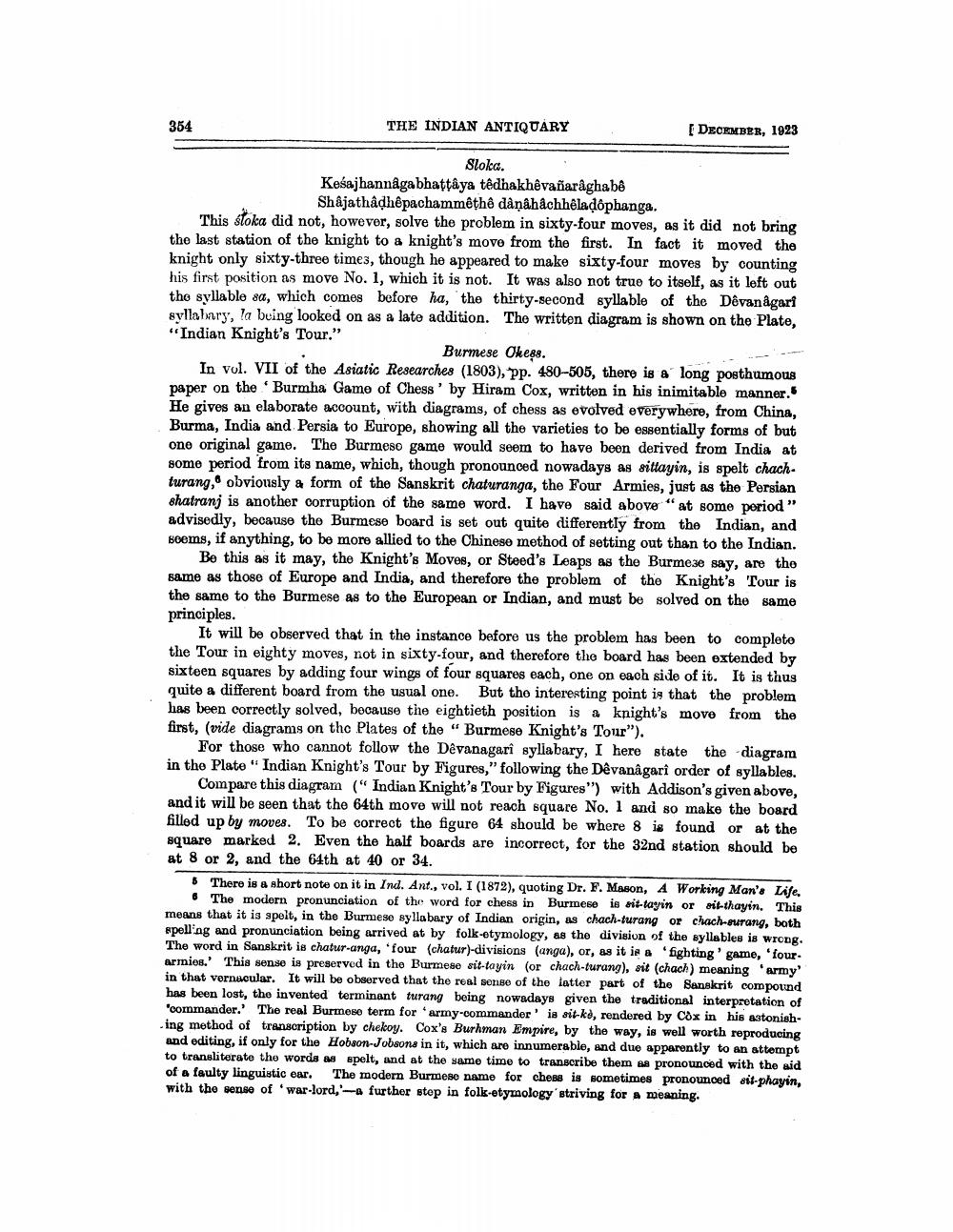________________
354
THE INDIAN ANTIQUARY
DECEMBER, 1923
Sloka. Kesajhannâgabhattâya têdhakhêvañarághabê
Shâjathadhêpachammêthê dânâhâchheladophanga. This stoka did not, however, solve the problem in sixty-four moves, as it did not bring the last station of the knight to a knight's move from the first. In fact it moved the knight only sixty-three times, though he appeared to make sixty-four moves by counting his first position as move No. 1, which it is not. It was also not true to itself, as it left out the syllable sa, which comes before ha, the thirty-second syllable of the Dôvan ågari gyllabary, la being looked on as a late addition. The written diagram is shown on the Plate, "Indian Knight's Tour."
Burmese Oke88. In vol. VII of the Asiatic Researches (1803), pp. 480-505, there is a long posthumous paper on the 'Burmha Game of Chess' by Hiram Cox, written in his inimitable manner. He gives an elaborate account, with diagrams, of chess as evolved everywhere, from China, Burma, India and Persia to Europe, showing all the varieties to be essentially forms of but one original game. The Burmese game would seem to have been derived from India at some period from its name, which, though pronounced nowadays as sittayin, is spelt chachturang, obviously a form of the Sanskrit chaturanga, the Four Armies, just as the Persian shatranj is another corruption of the same word. I have said above" at some poriod” advisedly, because the Burmese board is set out quite differently from the Indian, and Boems, if anything, to be more allied to the Chinese method of setting out than to the Indian.
Be this as it may, the Knight's Moves, or Steed's Leaps as the Burmeze say, are the same as those of Europe and India, and therefore the problem of the Knight's Tour is the same to the Burmese as to the European or Indian, and must be solved on the same principles.
It will be observed that in the instance before us the problem has been to complete the Tour in eighty moves, not in sixty-four, and therefore the board has been extended by sixteen squares by adding four wings of four squares each, one on each side of it. It is thus quite a different board from the usual one. But tho interesting point is that the problem has been correctly solved, because the eightieth position is a knight's move from the first, (vide diagrams on the Plates of the "Burmese Knight's Tour").
For those who cannot follow the Devanagari syllabary, I here state the diagram in the Plate "Indian Knight's Tour by Figures," following the Devanagari order of syllables.
Compare this diagram ("Indian Knight's Tour by Figures") with Addison's given above, and it will be seen that the 64th move will not reach square No. 1 and so make the board filled up by moves. To be correct the figure 64 should be where 8 is found or at the square marked 2. Even the half boards are incorrect, for the 32nd station should be at 8 or 2, and the 64th at 40 or 34.
8 There is a short note on it in Ind. Ant., vol. I (1872), quoting Dr. F. Mason, A Working Man's Life
6 The modern pronunciation of the word for chess in Burmese is sit-tayin or oil-thayin. This means that it is spelt, in the Burmese syllabary of Indian origin, as chach-turang or chach-surang, both spelling and pronunciation being arrived at by folk-etymology, as the division of the syllables is wrong. The word in Sanskrit is chatur-anga, 'four (chatur)-divisions (anga), or, as it is a "fighting game, 'four. armies. This sense is preserved in the Burmese sit-tayin (or chach-turang), sit (chach) meaning army in that vernacular. It will be observed that the real sense of the latter part of the Sanskrit compound has been lost, the invented terminant turang being nowadays given the traditional interpretation of 'oommander.' The real Burmese term for 'army-commander' is sit-ks, rendered by Cox in his astonishing method of transcription by chekoy. Cox's Burhman Empire, by the way, is well worth reproducing and editing, if only for the Hobson-Jobsons in it, which are innumerable, and due apparently to an attempt to transliterate the words a spelt, and at the same time to transcribe them se pronounced with the aid of a faulty linguistic ear. The modern Burmese name for chess is sometimes pronounced sit-phayin, with the sense of 'war-lord,-a further stop in folk-etymology striving for a meaning.




